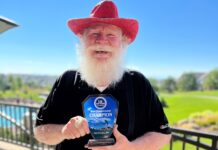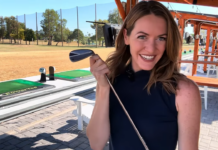By Nick Miller
 In Part I of our Q&A session with Mizuno Golf Club Engineer, Chris Voshall, we received some incredible insight as to why Mizuno remains at the forefront of the industry, with continued ingenuity and uncompromised quality of their products.
In Part I of our Q&A session with Mizuno Golf Club Engineer, Chris Voshall, we received some incredible insight as to why Mizuno remains at the forefront of the industry, with continued ingenuity and uncompromised quality of their products.
We conclude our exclusive sit-down to hear Voshall’s insight on where he sees the future of where club engineering headed, as well as some of the more memorable experiences he’s had while working with some of the best players in the world.
Q: Alright, Chris, let’s talk about players for a minute. You’ve had former World No. 1, Luke Donald, on staff for many years. What are some of the characteristics he looks for in the equipment he plays?
 A: Luke is one of the players who really knows what he likes in equipment. He has obvious visual requirements in terms of head shape, topline thickness, etc., but he also has feel requirements of specific frequencies to give that soft, solid impression on impact.
A: Luke is one of the players who really knows what he likes in equipment. He has obvious visual requirements in terms of head shape, topline thickness, etc., but he also has feel requirements of specific frequencies to give that soft, solid impression on impact.
One of the more interesting things with Luke, though, is how important turf interaction and sole shape are for him. We work very hard trying to dial in a sole to his very exacting standards in terms of how it enters and exits the turf. Without proper turf interaction it’s extremely difficult to ensure solid and consistent striking of the ball.
Q: Along those lines, it’s always fascinating to get a behind-the-scenes glimpse of the major professional tours. Considering all of the players worldwide Mizuno has on staff like Luke and the time you’ve spent on Tour, any interesting or funny stories that stand out in your memory?
A: I always love this question. There are a couple that pop into mind above the rest.
The first was a time I was testing with Luke Donald at Conway Farms just outside of Chicago. We were on the driving range testing drivers that day, and I was setting up our TrackMan to measure the shots. As I was setting up the target line, I asked Luke to aim between the trees a couple hundred yards down range. There was a tree sitting in the middle of the range, and then there were two other trees about five feet apart from each other, probably 30 yards to the right of the first tree.
I had requested that Luke shoot for this 30-yard gap, and when he hit his first two directly over the two trees on the right I just assumed he blocked each well right of this mark. But, it quickly dawned on me after his next one threaded the needle of these two trees again – and subsequently after many more to come – that his target and mine were quite different! These guys are good.
The other story that sticks in my mind to this day was my first time working on the range at a PGA Tour event. It was the old Bell South Classic held at TPC Sugarloaf, just outside of Atlanta.
I was walking down the range to get some balls when I was literally stopped in my tracks by the explosive sound of Bubba Watson hitting a driver. It was my first time seeing him live and up close. I just sat there and watched for a few minutes until I then looked over to my left and Kenny Perry was standing right there next to me watching as well. He said, “Pretty f*@^ing impressive, isn’t it?”
That was no doubt one of my favorite moments out there. Here’s a world-class player himself just as much in awe as everyone else watching.
Q: Our final question has to do with USGA regulations and the evolution of equipment over the last few years. As someone who’s entrenched in this daily, where do you see the future of golf equipment and club engineering headed?
A: While the USGA has continued to place regulations on and restrictions on clubs, I still see a lot of room for improvements. A few things you’ll continue to see are an evolution in materials and what they can allow engineers to do, while still sitting inside the guidelines drawn by the governing bodies. You’ll continue to see higher performing clubs getting smaller in size – game-improvement type performance out of a better player’s club size and shape. You’ll also see adjustability continue to evolve so it’s even more and more useful and functional.

One misconception out is that the ball can’t go any farther – that clubs are “at the limit.” While this is kind of true, it’s not entirely true.
What I mean is that all manufacturing processes have tolerances so clubs are designed to be conforming at all levels of those tolerances, but as manufacturing processes become more advanced and consistent, those tolerances will tighten and engineers will be able to target designs closer and closer to the exact rule numbers. This means clubs can still get slightly hotter and hit the ball farther.
As club engineers it is our job to figure out how to make these things perform better so we’ll continue to push every boundary imaginable!
Thanks again to Chris Voshall of Mizuno for taking the time to answer our questions and share his unique perspective on the club engineering and fitting industries!









